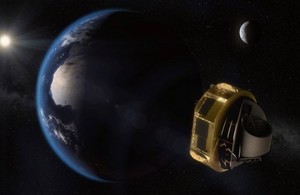Ariel
The UK-led Ariel mission will study the atmospheres of approximately 1000 planets lying outside our Solar System.

Image of ARIEL in space net to Earth [Credit: ARIEL space mission / ESA]
Ariel will help scientists understand the key processes which form planetary systems and affect how they evolve.
- Ariel is a UK proposed medium class mission within the European Space Agency’s Science Programme
- the UK is coordinating the mission’s science objectives and leading an international consortium of 17 countries building the mission’s payload module
- the UK Space Agency has committed over £6 million to support UK teams during Ariel’s definition phase up to March 2022, with further funding currently being reviewed
- Airbus Defence and Space UK are part of the mission’s core industrial team, working under contract to ESA developing the spacecraft platform, leading on avionics, payload interface and electrical design
Overview
Thousands of exoplanets have now been discovered with a huge diversity of masses, sizes and orbits, but very little is known about their chemical composition, formation, or their evolutionary links to their host stars.
Ariel will carry out the first ever large-scale survey of exoplanets specifically to examine and characterise their atmospheres. By returning large amounts of data for the first time Ariel will highlight trends and correlations between planets and their systems to answer the following science questions:
- what are exoplanets made of?
- how do planets and planetary systems form?
- how do planets and their atmospheres evolve over time?
Expected to launch in 2029, in its four-year mission Ariel will survey a diverse sample of about 1000 extra-solar planets, simultaneously in visible and infrared wavelengths. It is the first mission dedicated to measuring the chemical composition and thermal structures of hundreds of transiting exoplanets, enabling planetary science far beyond the boundaries of the Solar System.
Timeline, current status and next steps
| Date | Status |
|---|---|
| March 2018 | Ariel proposal selected by ESA as fourth Medium Class (M4) mission in its Cosmic Vision programme. |
| May 2019 | Completion of Intermediary payload design consolidation review, a progress checkpoint of the study phase. |
| March 2020 | Completion of payload Systems Requirements Review, examining system architecture and sub-assemblies against mission requirements. |
| November 2020 | Ariel formally adopted by ESA Science Programme Committee as M4 mission of ESA’s Cosmic Vision programme. |
| Mid 2022 | Payload Preliminary Design Review to finalise plans and hardware models, refine schedule and mature designs. |
| July 2024 | The Ariel Data Challenge 2024 opens, inviting data scientists, astronomers, and AI enthusiasts to find ways of extracting faint exoplanetary signals from noisy space telescope observations. |
| Early 2025 | Payload Critical Design Review to finalise the design and detailed definition of interfaces. |
| 2026 to 2027 | Delivery of Payload Flight Model for integration with the Ariel spacecraft. |
| Early 2029 | Flight Acceptance Review to complete testing and authorise delivery for launch. |
| Mid 2029 | Launch. |
| 2029 to 2033 | Four-year nominal science operations phase. |
Further Information
Find out more about the Ariel mission on ESA’s website and the Ariel Space Mission website.
UK involvement
The UK exoplanet science community is one of the largest and most successful in the world, involved in a broad range of observational and theoretical projects. Leadership of Ariel puts the UK at the heart of the next logical step in exoplanet research, as it evolves from discovery to characterisation, and enables the mission’s science planning to be built around UK strengths and interests.
The payload leadership role provides the UK with a deep understanding of the design of the Ariel mission. This then informs the research undertaken using the data returned from the spacecraft; UK scientists will have an intimate knowledge of the performance of the payload, which will help them be ready to interpret the data and maximise UK science return.
Opportunities for UK industry in Active Cooler System development work and payload detector technologies – developing solutions for Ariel that can be reused in the future for other applications.
The discovery of more than 2000 exoplanets in recent years is a major achievement in modern astronomy and resonates strongly with the general public. Being able to take this work into the classroom and the public sphere is key to finding and inspiring the next generation of scientists and engineers. Several outreach projects and programmes have been delivered by the UK Ariel team so far, with more planned over the mission’s next phase.
UK Space Agency funding currently supports core roles shaping the mission.
Leading the mission from the UK: the mission’s Principal Investigator at University College London (UCL), Professor Giovanna Tinetti, will lead Ariel science development.
Building and testing the Ariel payload module: Rutherford Appleton Laboratory in Harwell, Oxfordshire will assemble, integrate, and test the Ariel payload module, managing the instrument, telescope and other hardware contributions from the European consortium, as well as the development of the payload’s £5.5 million cryogenic Active Cooler System.
Performance analysis & Science Ground Segment: Scientists at University of Cardiff and UCL will develop comprehensive end-to-end mission simulations to test and fine-tune the complex algorithms that drive Ariel data retrievals, this activity is overseen by Ariel Payload Scientist Professor Giorgio Savini, UCL. The UK is also deputy lead of the Ariel Science Ground Segment, ensuring close involvement in data processing and calibration.
Optical ground support equipment, University of Oxford: Delivery of equipment which will provide end to end testing of the Ariel payload’s telescope and optical elements.
Updates to this page
-
Updates made throughout the page, and changes made to page structure.
-
Updated December 2021
-
First published.